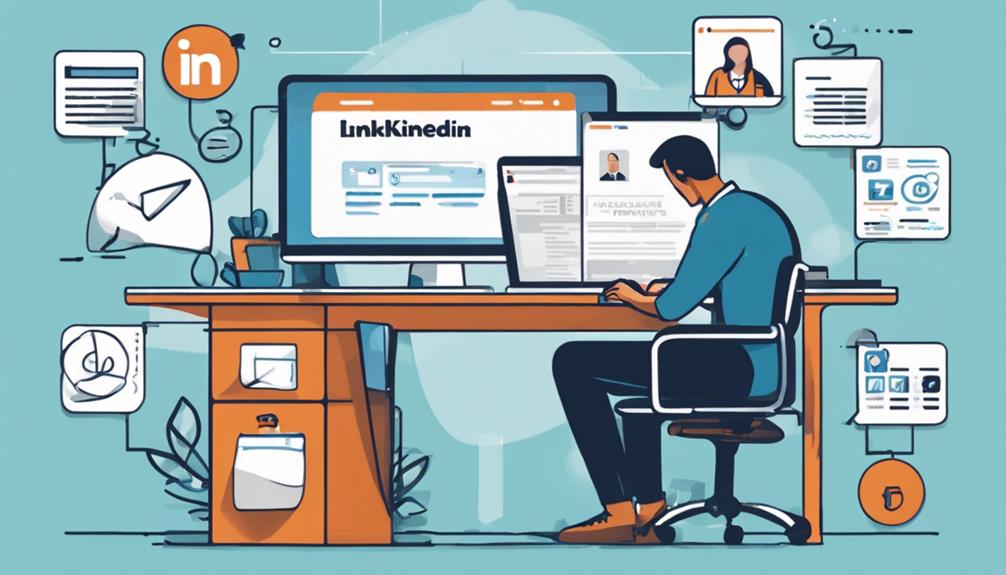No products in the cart.
On LinkedIn, '3rd' marks the outer circle of your professional network, tagged as your 3rd-degree connections. Imagine friends of your friends' friends—that's them. These are people you don't know yet but are linked through mutual connections. Tapping into this group can massively broaden your networking horizon, opening doors to fresh opportunities and insights. It's a bit more challenging to engage since you don't have direct mutual friends, but with a personalized approach, you can turn these potential contacts into valuable parts of your professional world. By leveraging these connections wisely, you're set to inject new perspectives and grow your network. Stick around to reveal the secrets of making those crucial connections.
Contents
hide
Key Takeaways
- '3rd' on LinkedIn refers to 3rd-degree connections, individuals not directly connected to you but linked through your 2nd-degree connections.
- These connections represent a broader network reach, offering new professional opportunities and insights.
- Engaging with 3rd-degree connections can expand your professional network and open doors to new collaborations or job prospects.
- Personalized outreach, like tailored connection requests, is key to effectively engaging with 3rd-degree connections on LinkedIn.
- Utilizing LinkedIn's features, such as InMail and Groups, can facilitate meaningful interactions with 3rd-degree connections.
Understanding 3rd-Degree Connections
Exploring the domain of LinkedIn, you'll discover that 3rd-degree connections are the hidden gems that can greatly broaden your professional network. These individuals, linked through your 2nd-degree connections, aren't directly in your circle yet, but they're pivotal for your networking strategies and professional outreach. To tap into this vast reservoir of potential, you'll need to send connection requests, a move that requires tact and a personalized approach.
Crafting a strategy to engage with 3rd-degree connections requires leveraging LinkedIn's features like groups and events. Joining groups where these connections are active, or attending virtual events they're interested in, can serve as common ground for initial conversations. Remember, the key to converting these connections into meaningful professional relationships lies in personalization. A generic message won't cut it. Instead, tailor your messages to reflect shared interests or connections, making your outreach resonate on a personal level.
This approach not only enhances your visibility among a broader network of professionals but also diversifies your network with individuals from varying backgrounds and industries. It's a proactive step towards expanding your professional landscape, one connection request at a time.
Importance of Connection Levels
Understanding the importance of connection levels on LinkedIn can greatly enhance your networking strategy. When you're aware that '3rd' signifies connections without mutual friends, you recognize the challenge but also the potential for expanding your network reach. Unlike 1st and 2nd-degree connections, interacting with 3rd-degree connections requires a bit more effort, such as sending connection requests. However, this effort can be well worth it for building relationships beyond your immediate circle.
Leveraging tools like LinkedIn's Sales Navigator can be a game-changer in connecting with 3rd-degree professionals effectively. It's about being strategic and using the right tools to bridge the gap. Engaging with shared content and crafting personalized messages are key networking strategies that can significantly enhance your acceptance rates with these connections. Remember, it's not just about adding numbers to your network; it's about meaningful engagement that can lead to valuable relationships.
Finding 3rd-Degree Connections
You've tackled connecting with those you know directly and those one step away, but what about 3rd-degree connections on LinkedIn?
Identifying and reaching out to these further-flung contacts can open doors you didn't know existed, offering fresh opportunities and insights.
Let's explore how to pinpoint these valuable connections and why they're worth the extra effort.
Identifying 3rd-Degree Connections
Identifying 3rd-degree connections on LinkedIn can greatly broaden your professional network, offering new opportunities for collaboration and insight. These connections, not directly linked to you or your closer network, are key to innovative networking strategies and connection expansion.
You'll need to send a connection request to interact, as they're further removed from your immediate circle. To bridge this gap, consider engaging with shared content or joining relevant groups, paving the way for mutual connections.
LinkedIn's advanced search filters and outreach tools are your best friends here, making it easier to pinpoint and connect with these 3rd-degree users effectively. Embracing these strategies not only widens your professional landscape but also injects fresh perspectives into your network.
Benefits of 3rd-Degree Connections
Delving into the world of 3rd-degree connections on LinkedIn can greatly broaden your networking horizons, opening doors to new opportunities and collaborations. Though these connections require more effort since there's no mutual link, the rewards are worth it.
By expanding your reach beyond immediate contacts, you're not just adding names to your list; you're building rapport with a wider community. Utilizing LinkedIn's search filters can pinpoint individuals who align with your professional goals, making it easier to forge meaningful connections.
Engaging with 3rd-degree connections isn't just about growing numbers—it's about enhancing your networking benefits. This proactive approach to building relationships can significantly boost your professional growth, ensuring you're always a step ahead in the networking game.
Engaging With Potential Contacts
To effectively engage with potential contacts on LinkedIn, especially those who are 3rd-degree connections, it's important to craft personalized messages that resonate with their interests and professional background. Incorporating elements like shared interests or mutual goals can greatly enhance your chances of making a meaningful connection. Remember, effective outreach is all about quality, not quantity. Take the time to research and understand their profile, which lays the foundation for building rapport.
Here's a quick guide to help you navigate this process:
| Strategy | Description |
|---|---|
| LinkedIn InMails | Utilize InMails for direct messaging, ensuring your approach is personalized and thoughtful. |
| Engage with Content | Comment on or share their posts to demonstrate genuine interest and initiate conversation. |
| Omnichannel Outreach | Extend your interaction beyond LinkedIn by engaging on other professional platforms or via email. |
| Personalized Engagement | Tailor your message to reflect their professional interests, achievements, or shared connections. |
Engaging with your 3rd-degree connections on LinkedIn doesn't have to be overwhelming. By personalizing your approach and showing genuine interest, you're more likely to foster meaningful professional relationships.
Personalizing Connection Requests
After mastering the art of engaging with potential contacts, it's time you focus on refining your connection requests to greatly boost your acceptance rates on LinkedIn. Personalized invitations aren't just a nicety; they're a necessity. By incorporating connection tips that hinge on personalization, you're not just shooting in the dark; you're making every shot count.
Start with the basics: use the recipient's name. It's a simple touch, but it can amp up your acceptance rates by 22%. Dive deeper by mentioning shared interests or experiences, which can skyrocket your response rates by 50%. It's all about finding that common ground that transforms a cold call into a warm welcome.
Don't overlook the power of mutual connections. Dropping a common name can bump up your acceptance rates by 10-20%. It's like getting an informal nod of approval. And here's the clincher: adding a personalized note to your request can elevate your acceptance rate by a staggering 60%.
Think of your connection request as your first impression. Make it count. By personalizing your approach, you're not just reaching out; you're inviting a conversation. And in the world of LinkedIn, that's gold.
Leveraging LinkedIn Groups
Jumping into relevant LinkedIn groups isn't just about browsing; it's your ticket to widening your professional circle.
By networking within these groups, you're stepping beyond your usual contacts and tapping into a world where 3rd-degree connections become accessible allies.
It's where shared interests and active engagement transform strangers into potential colleagues or collaborators.
Joining Relevant Groups
Delving into LinkedIn groups related to your field can greatly enhance your network by connecting you with like-minded 3rd-degree connections. By engaging in these specialized communities, you discover a goldmine of networking opportunities, setting the stage for meaningful industry connections to blossom.
The key lies in active group participation. Don't just be a spectator; immerse yourself in discussions, share insights, and contribute valuable content. This proactive approach not only boosts your visibility but also positions you as a thought leader in your sphere.
Networking Within Groups
Harnessing LinkedIn groups, you'll open the door to building stronger connections with 3rd-degree contacts who share your professional passions and interests. By diving into these specialized communities, you're not just expanding your network; you're enriching it with meaningful interactions that go beyond the surface level.
- Actively participate in group discussions to catch the eye of like-minded professionals.
- Share your insights and expertise to become a go-to resource within the group.
- Reconnect with alumni through dedicated networks, broadening your reach.
- Attend industry-specific LinkedIn events to meet 3rd-degree contacts in real-time.
Leveraging these networking strategies within professional communities fosters group interactions that are invaluable. You're not just building relationships; you're cultivating a thriving professional ecosystem where every connection counts.
Utilizing LinkedIn InMail
To access networking potential with 3rd-degree connections, you'll find LinkedIn InMail an indispensable tool. This feature allows you to send messages directly to individuals you're not yet connected with, opening doors to countless business and networking opportunities. If you're looking to make your outreach engaging and receive a higher response rate, crafting customized messages is key.
With InMail part of Premium, Sales Navigator, and Recruiter subscriptions, investing in one of these plans opens up the ability to reach beyond your immediate network. This is particularly valuable when you're eyeing potential leads, partners, or clients who are just outside your first and second-degree connections. Personalization is your best friend here; generic messages often get lost in the shuffle. By mentioning specific details that relate to the recipient's experience or industry, you show genuine interest and stand out.
Expanding Your LinkedIn Network
Expanding your LinkedIn network, especially with 3rd-degree connections, can greatly broaden your professional horizon. By harnessing the power of networking strategies and building connections, you're not just adding names to your list; you're discovering opportunities and insights from a broader spectrum.
To make the most out of connecting with 3rd-degree connections, consider these pointers:
- Send personalized connection requests: A customized message can set the stage for a meaningful connection, making it clear why you're reaching out.
- Engage with their content: Liking, commenting, and sharing their posts can get you noticed and help build rapport before you even introduce yourself.
- Utilize LinkedIn Groups and Events: These can be treasure troves for finding and interacting with 3rd-degree connections who share your interests or industry.
- Leverage LinkedIn Sales Navigator: For a more targeted approach, this tool can refine your search and help you identify the most relevant 3rd-degree connections.
Frequently Asked Questions
What Does It Mean 1st 2nd 3rd on Linkedin?
On LinkedIn, 1st, 2nd, and 3rd refer to connection levels, shaping your networking strategy. They're how closely you're connected to someone, from direct contacts to those a few degrees removed, affecting how you interact.
What Does the +3 Mean on Linkedin?
On LinkedIn, the "+3" signifies you're looking at a 3rd-degree connection. You'll need savvy networking strategies and profile optimization to bridge this gap. It's all about making your presence engaging to catch their attention.
Can You Connect With a 3rd on Linkedin?
Yes, you can connect with a 3rd on LinkedIn! Use smart connection strategies and follow networking etiquette by sending personalized requests. It's a great way to broaden your network and uncover new opportunities.
Why Can't I See 2nd Connections on Linkedin?
You can't see 2nd connections on LinkedIn due to privacy settings and connection limits. These rules protect user info and maintain confidentiality, ensuring you're only clued into your direct network. It's all about privacy!
Conclusion
You've dived deep into the world of LinkedIn, unraveling the mystery of 3rd-degree connections. Now, you're equipped to expand your network like a pro. Remember, it's all about engaging authentically, personalizing those requests, and jumping into groups and InMail with confidence.
Every connection is a potential opportunity, so leverage what you've learned and watch your professional circle grow. Get out there, make those connections, and turn those 3rd-degree contacts into first-rate opportunities. You've got this!






